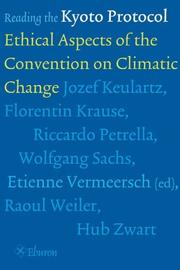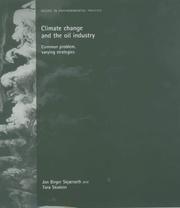Book
Year: 2007 Publisher: Washington, D.C., The World Bank,
Abstract | Keywords | Export | Availability | Bookmark
 Loading...
Loading...Choose an application
- Reference Manager
- EndNote
- RefWorks (Direct export to RefWorks)
This paper uses the Ricardian approach to examine how farmers in 11 countries in Africa have adapted to existing climatic conditions. It then estimates the effects of predicted changes in climate while accounting for whatever farmer adaptation might occur. This study differs from earlier ones by using farmers' own perceptions of the value of their land. Previous research, by contrast, has relied on either observed sale prices or net revenues, sometimes aggregated over geographically large tracts of terrain. The study also makes use of high resolution data describing soil quality and runoff. Furthermore, it tackles the challenges involved in modeling the effect of climate on agriculture in a study that includes countries in the northern and southern hemispheres, as well as the tropics. The study confirms that African agriculture is particularly vulnerable to climate change. Even with perfect adaptation, regional climate change by 2050 is predicted to entail production losses of 19.9 percent for Burkina Faso and 30.5 percent for Niger. By contrast, countries such as Ethiopia and South Africa are hardly affected at all, suffering productivity losses of only 1.3 percent and 3 percent, respectively. The study also confirms the importance of water supplies as measured by runoff, which, being affected by both temperature and precipitation, may itself be highly sensitive to climate change.
Climate --- Climate Change --- Climate change research --- Common Property Resource Development --- Emissions --- Environment --- Global Environment --- Global warming --- Kyoto Protocol --- Potential impacts --- Precipitation --- Rural Development --- Rural Development Knowledge and Information Systems --- Soil --- Temperature
Book
Year: 2007 Publisher: Washington, D.C., The World Bank,
Abstract | Keywords | Export | Availability | Bookmark
 Loading...
Loading...Choose an application
- Reference Manager
- EndNote
- RefWorks (Direct export to RefWorks)
This paper uses the Ricardian approach to examine how farmers in 11 countries in Africa have adapted to existing climatic conditions. It then estimates the effects of predicted changes in climate while accounting for whatever farmer adaptation might occur. This study differs from earlier ones by using farmers' own perceptions of the value of their land. Previous research, by contrast, has relied on either observed sale prices or net revenues, sometimes aggregated over geographically large tracts of terrain. The study also makes use of high resolution data describing soil quality and runoff. Furthermore, it tackles the challenges involved in modeling the effect of climate on agriculture in a study that includes countries in the northern and southern hemispheres, as well as the tropics. The study confirms that African agriculture is particularly vulnerable to climate change. Even with perfect adaptation, regional climate change by 2050 is predicted to entail production losses of 19.9 percent for Burkina Faso and 30.5 percent for Niger. By contrast, countries such as Ethiopia and South Africa are hardly affected at all, suffering productivity losses of only 1.3 percent and 3 percent, respectively. The study also confirms the importance of water supplies as measured by runoff, which, being affected by both temperature and precipitation, may itself be highly sensitive to climate change.
Climate --- Climate Change --- Climate change research --- Common Property Resource Development --- Emissions --- Environment --- Global Environment --- Global warming --- Kyoto Protocol --- Potential impacts --- Precipitation --- Rural Development --- Rural Development Knowledge and Information Systems --- Soil --- Temperature
Book
Year: 2012 Publisher: Washington, D.C., The World Bank,
Abstract | Keywords | Export | Availability | Bookmark
 Loading...
Loading...Choose an application
- Reference Manager
- EndNote
- RefWorks (Direct export to RefWorks)
This paper examines the cost of producing emission reduction credits under the Clean Development Mechanism. Using project-specific data, cost functions are estimated using alternative functional forms. The results show that, in general, the distribution of projects in the pipeline does not correspond exclusively to the cost of generating anticipated credits. Rather, investment choices appear to be influenced by location and project type considerations in a way that is consistent with variable transaction costs and investor preferences among hosts and classes of projects. This implies that comparative advantage based on the marginal cost of abatement is only one of several factors driving Clean Development Mechanism investments. This is significant since much of the conceptual and applied numerical literature concerning greenhouse gas mitigation policies relies on presumptions about relative abatement costs. The authors also find that Clean Development Mechanism projects generally exhibit constant or increasing returns to scale. In contrast, they find variations among classes of projects concerning economies of time.
Abatement costs --- Agriculture --- CDM --- Climate Change Economics --- Climate Change Mitigation and Green House Gases --- Energy and Environment --- Energy Production and Transportation --- Greenhouse gas emissions --- Kyoto Protocol --- Projects --- Rural Development --- Transport Economics Policy & Planning

ISBN: 9059720644 Year: 2005 Publisher: Delft Eburon
Abstract | Keywords | Export | Availability | Bookmark
 Loading...
Loading...Choose an application
- Reference Manager
- EndNote
- RefWorks (Direct export to RefWorks)
Environmental protection. Environmental technology --- Meteorology. Climatology --- Professional ethics. Deontology --- klimaat --- Kyoto-protocol --- CLIMATE CHANGE -- 323.39 --- CLIMATE CHANGE -- 327.3 --- Energie --- Algemeen --- 540 Luchtverontreiniging --- Broeikaseffect --- 061 Ethische problemen --- Milieubeleid 504.7:338 --- Luchtverontreiniging 614.71 --- Maatschappelijke ontwikkeling 304 --- Sociaal beleid 304:32 --- Klimaat 504.38 --- 551.58 klimaat --- 551.583 klimaatverandering --- 170 ethiek --- Algemeen. --- Monograph
Book
ISBN: 9782296017788 2296017789 Year: 2006 Publisher: Paris : l'Harmattan,
Abstract | Keywords | Export | Availability | Bookmark
 Loading...
Loading...Choose an application
- Reference Manager
- EndNote
- RefWorks (Direct export to RefWorks)
Greenhouse gases --- Climatic changes --- Gaz à effet de serre --- Climat --- Environmental aspects --- Government policy --- Aspect de l'environnement --- Changements --- Politique gouvernementale --- United Nations Framework Convention on Climate Change (1992). Protocols, etc., 1997 Dec. 11. --- Climate Change --- International Negotiations --- Eastern European Developing Countries --- Kyoto Protocol

ISBN: 1862031681 Year: 2006 Publisher: London Chatham House
Abstract | Keywords | Export | Availability | Bookmark
 Loading...
Loading...Choose an application
- Reference Manager
- EndNote
- RefWorks (Direct export to RefWorks)
Environmental policy --- Emissions trading --- Air --- Emissions credit trading --- Emissions rights trading --- Marketable permits for carbon dioxide emissions --- Tradeable emission permits --- Trading emissions credits --- Carbon offsetting --- Carbon taxes --- Pollution --- United Nations Framework Convention on Climate Change --- Jingdu tiao yue --- Jingdu xie yi shu --- Jingdu yi ding shu --- Konvensi Perubahan Iklim --- Kyōto giteisho --- Kyoto Protocol --- Kyoto Treaty --- Lian he guo qi hou bian hua kuang jia gong yue de Jingdu yi ding shu --- Protokol Kyoto --- Protokol Kyoto Untuk Konvensi Kerangka Kerja PBB Tentang Perubahan Iklim --- 京都协议书 --- 京都条约 --- 京都議定書 --- 京都议定书 --- 联合国气候变化框架公约的京都议定书
Multi
ISBN: 9789028971844 Year: 2014 Publisher: Kapellen Pelckmans
Abstract | Keywords | Export | Availability | Bookmark
 Loading...
Loading...Choose an application
- Reference Manager
- EndNote
- RefWorks (Direct export to RefWorks)
Map bevat 39 A3-platen.
Bijbelverhalen. --- Conflicthantering. --- Eucharistie. --- Godsdienst --- Kerkelijk jaar. --- Kerstmis. --- Mozes. --- Nieuwe Testament. --- Oude Testament. --- Pasen. --- Basisonderwijs. --- 478.61 --- godsdienst --- Bijbelverhalen --- Godsdienst ; basisonderwijs --- 244.5 --- kijkplaten --- Schoolbooks - Didactic material --- Lager onderwijs --- 4e leerjaar lager onderwijs --- Basisonderwijs --- Kwartetspelen --- Kerkelijke feesten --- Kerken --- Plattegronden --- Jozef --- Diversiteit --- Zondaars --- Christus --- Schilderijen --- Kunsten --- Rothko, Mark --- Welzijnszorg --- Sociale welzijnszorg --- Kerstmis --- Herders --- Mozes --- Egypte --- Tien Geboden --- Chagall, Marc --- Kruisweg --- Laatste avondmaal --- Judas --- Bijbel --- Symbolen --- Franciscus van Assisi (heilige) --- Kyoto-Protocol --- Kwartetspel --- Filosofie --- Psychologie --- Sociologie --- Man --- Cultuur --- Erfelijkheidsleer --- Stadssamenleving --- Verpleegkunde --- Volwassene --- Kerkelijk feest --- Kerk (gebouw) --- Plattegrond --- Jozef (vader van Jezus) --- Inclusie --- Maatwerk --- Zondaar --- Jezus Christus --- Schilderij --- Kunst --- Zorg- en welzijnssector --- Herder --- Symbool --- Fransiscus van Assisi (heilige) --- Sint-Jozef (heilige)
Book
ISBN: 9781606502747 1606502743 9781606502723 1606502727 128389579X Year: 2011 Publisher: [New York, N.Y.] (222 East 46th Street, New York, NY 10017) : Momentum Press,
Abstract | Keywords | Export | Availability | Bookmark
 Loading...
Loading...Choose an application
- Reference Manager
- EndNote
- RefWorks (Direct export to RefWorks)
People are currently paying much attention to the ability of present and future human populations to influence Earth's climate through the emission of greenhouse gases (GHGs) such as carbon dioxide. According to some, such a self-induced change in our physical environment qualifies humans for the distinction of a "superspecies" that has passed a threshold of biological evolution. Some 2 to 3 billion years ago, another organism changed the environment in a very pronounced way: a primitive unicellular organism called cyanobacteria (blue- green algae). These cyanobacteria "discovered" a new energy source that enabled them to develop a photosynthetic apparatus that assimilates carbon dioxide through conversion of solar energy to chemical energy. In the process, a "useless" waste product, oxygen, began to accumulate and gradually changed the composition of the atmosphere. As a result, new, more complex oxygen-consuming forms of life evolved, eventually leading to humans. The algae that started it all, while still flourishing, then became the first link in a very elaborate food chain.
Climatic changes. --- Global warming. --- Energy policy. --- Energy and state --- Power resources --- State and energy --- Industrial policy --- Energy conservation --- Global warming --- Warming, Global --- Global temperature changes --- Greenhouse effect, Atmospheric --- Changes, Climatic --- Changes in climate --- Climate change --- Climate change science --- Climate changes --- Climate variations --- Climatic change --- Climatic changes --- Climatic fluctuations --- Climatic variations --- Global climate changes --- Global climatic changes --- Climatology --- Climate change mitigation --- Teleconnections (Climatology) --- Government policy --- Environmental aspects --- Carbon footprints --- Earth Summit --- Fossil fuels --- Genocide --- Greenhouse gases --- Intergovernmental Panel on Climate Change (IPCC) --- Just World Hypothesis --- Kyoto Protocol --- Sustainable energy --- World Bank --- Global environmental change
Book
Year: 2008 Publisher: Washington, D.C. : The World Bank,
Abstract | Keywords | Export | Availability | Bookmark
 Loading...
Loading...Choose an application
- Reference Manager
- EndNote
- RefWorks (Direct export to RefWorks)
This strategic framework serves to guide and support the operational response of the World Bank Group (WBG) to new development challenges posed by global climate change. Unabated, climate change threatens to reverse hard-earned development gains. The poorest countries and communities will suffer the earliest and the most. Yet they depend on actions by other nations, developed and developing. While climate change is an added cost and risk to development, a well-designed and implemented global climate policy can also bring new economic opportunities to developing countries. Climate change demands unprecedented global cooperation involving a concerted action by countries at different development stages supported by "measurable, reportable, and verifiable" transfer of finance and technology to developing countries. Trust of developing countries in equity and fairness of a global climate policy and neutrality of the supporting institutions is critical for such cooperation to succeed. Difficulties with mobilizing resources for achieving the millennium development goals and with agreeing on global agricultural trade underscore the political challenges. The framework will help the WBG maintain the effectiveness of its core mission of supporting growth and poverty reduction. While recognizing added costs and risks of climate change and an evolving global climate policy. The WBG top priority will be to build collaborative relations with developing country partners and provide them customized demand-driven support through its various instruments from financing to technical assistance to constructive advocacy. It will give considerable attention to strengthening resilience of economies and communities to increasing climate risks and adaptation. The operational focus will be on improving knowledge and capacity, including learning by doing. The framework will guide operational programs of WBG entities to support actions whose benefits to developing countries are robust under significant uncertainties about future climate policies and impacts-actions that have "no regrets."
Afforestation --- Capital Markets --- Carbon Credits --- Carbon Dioxide --- Carbon Finance --- Clean Energy --- Climate --- Climate Change --- Climate Change and Environment --- Coal --- Coastal Areas --- Credit --- Decision Making --- Deforestation --- Developed Countries --- Economic Development --- Economics --- Ecosystems --- Electricity --- Emissions --- Energy --- Energy and Environment --- Energy Efficiency --- Energy Production and Transportation --- Energy Security --- Energy Supply --- Environment --- Environment and Energy Efficiency --- Environmental Economics & Policies --- Equity --- Food Production --- Forests --- Fossil Fuels --- Gdp --- Geothermal Energy --- Hydropower --- Incentives --- Insurance --- Intergovernmental Panel On Climate Change --- International Energy Agency --- Knowledge --- Kyoto Protocol --- Land --- Malaria --- Natural Resources --- Nuclear Power --- Population Growth --- Poverty --- Power Sector --- Productivity --- Rainfall --- Renewable Energy --- Risk --- Risk Management --- Savings --- Securities --- Streams --- Temperature --- Trade --- Vehicles --- Waste --- Water --- Water Use --- Wetlands

ISBN: 1781700478 1280734515 9786610734511 1847790828 1423706544 0719065585 0719065593 9781280734519 9781526137296 6610734518 9781847790828 9781423706540 1526137291 Year: 2003 Publisher: Manchester : New York : Manchester University Press : Distributed exclusively in the USA by Palgrave,
Abstract | Keywords | Export | Availability | Bookmark
 Loading...
Loading...Choose an application
- Reference Manager
- EndNote
- RefWorks (Direct export to RefWorks)
Multinational corporations are not merely the problem in environmental concerns, but could also be part of the solution. The oil industry and climate change provide the clearest example of how the two are linked; what is less well-known is how the industry is responding to these concerns. This volume presents a detailed study of the climate strategies of ExxonMobil, Shell and Statoil. With an innovative analytical approach, the authors explain variations at three decision-making levels: within the companies themselves, in the national home-bases of the companies, and at an international level. The analysis generates policy-relevant knowledge about whether and how corporate resistance to a viable climate policy can be overcome. The analytical approach developed by the authors is also applicable to other areas of environmental degradation where multinational corporations play a central role. The book is invaluable to students, researchers and practitioners interested in national and international environmental politics and business environmental management.
Petroleum industry and trade --- Gas industry --- Industrial management --- Greenhouse gas mitigation. --- Climatic changes. --- Environmental aspects. --- Changes, Climatic --- Climate change --- Climate changes --- Climate variations --- Climatic change --- Climatic changes --- Climatic fluctuations --- Climatic variations --- Global climate changes --- Global climatic changes --- Abatement of greenhouse gas emissions --- Emission reduction, Greenhouse gas --- Emissions reduction, Greenhouse gas --- GHG mitigation --- Greenhouse gas abatement --- Greenhouse gas emission reduction --- Greenhouse gas emissions reduction --- Greenhouse gas reduction --- Mitigation of greenhouse gas emissions --- Reduction of greenhouse gas emissions --- Natural gas industry --- Environmental aspects --- Climatology --- Climate change mitigation --- Teleconnections (Climatology) --- Pollution prevention --- Energy industries --- Changes in climate --- Climate change science --- Global environmental change --- environmentalism --- oil --- exxon --- multinational --- Climate change (general concept) --- Equinor --- ExxonMobil --- Fossil fuel --- Kyoto Protocol --- Netherlands --- Norway --- Petroleum industry --- Politics of global warming --- Royal Dutch Shell

 Search
Search Feedback
Feedback About
About Help
Help News
News